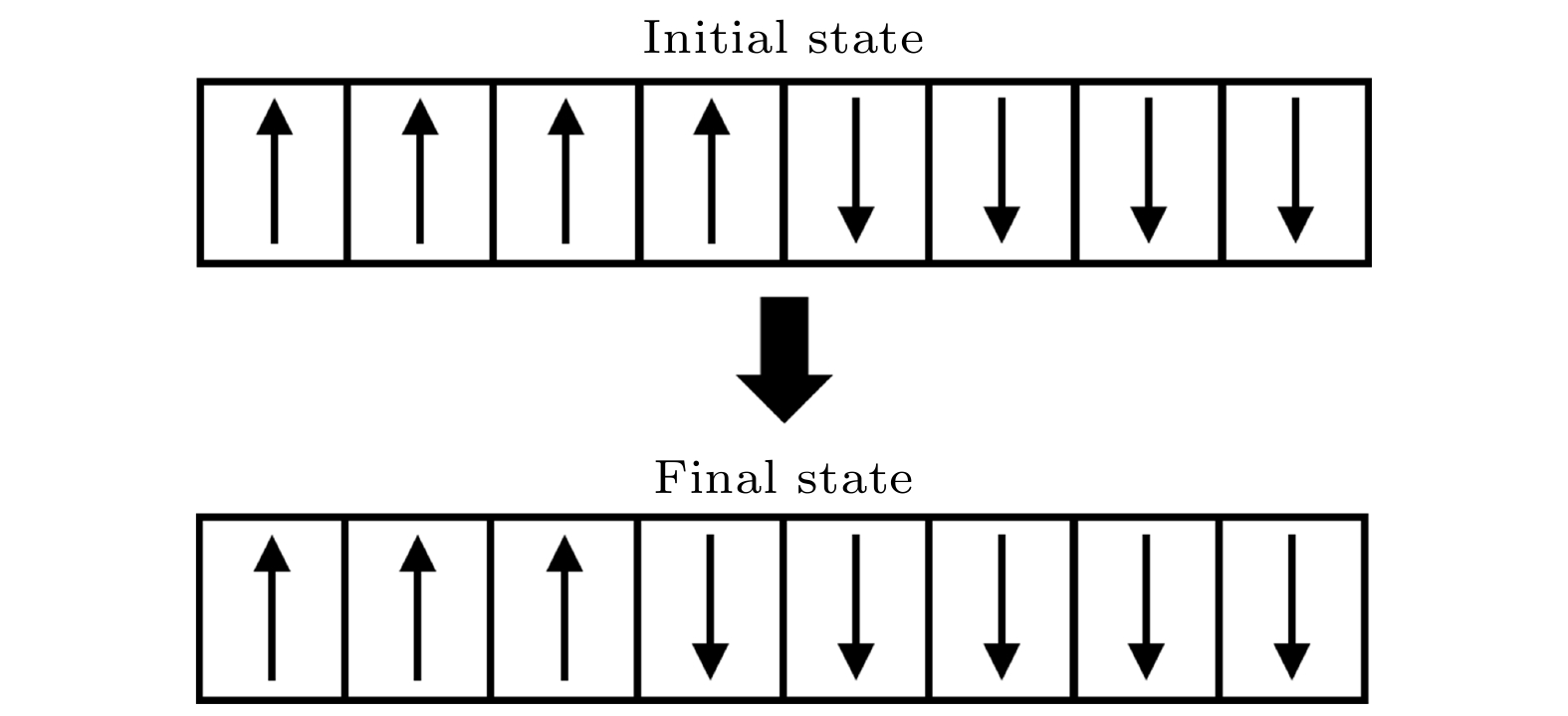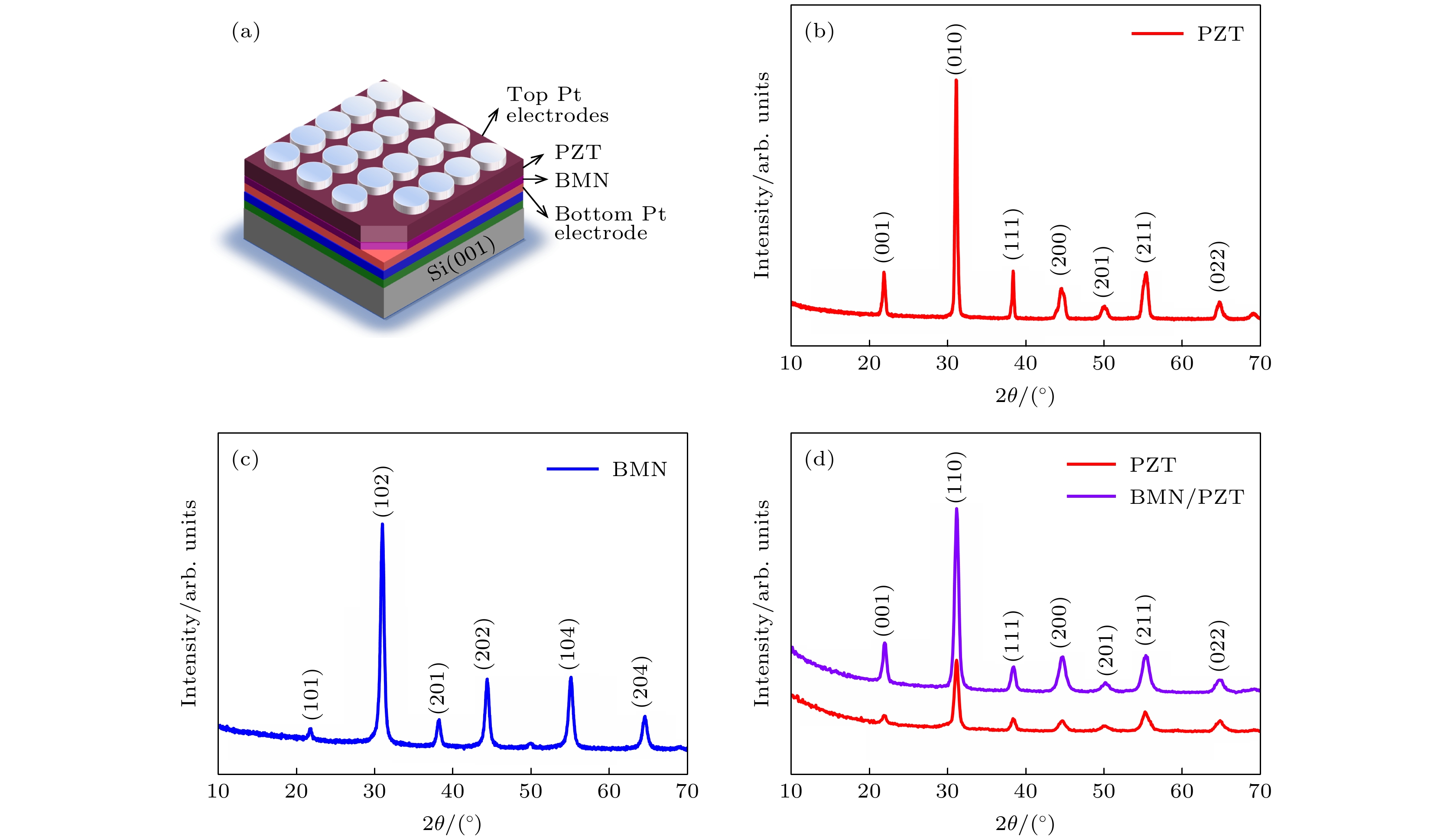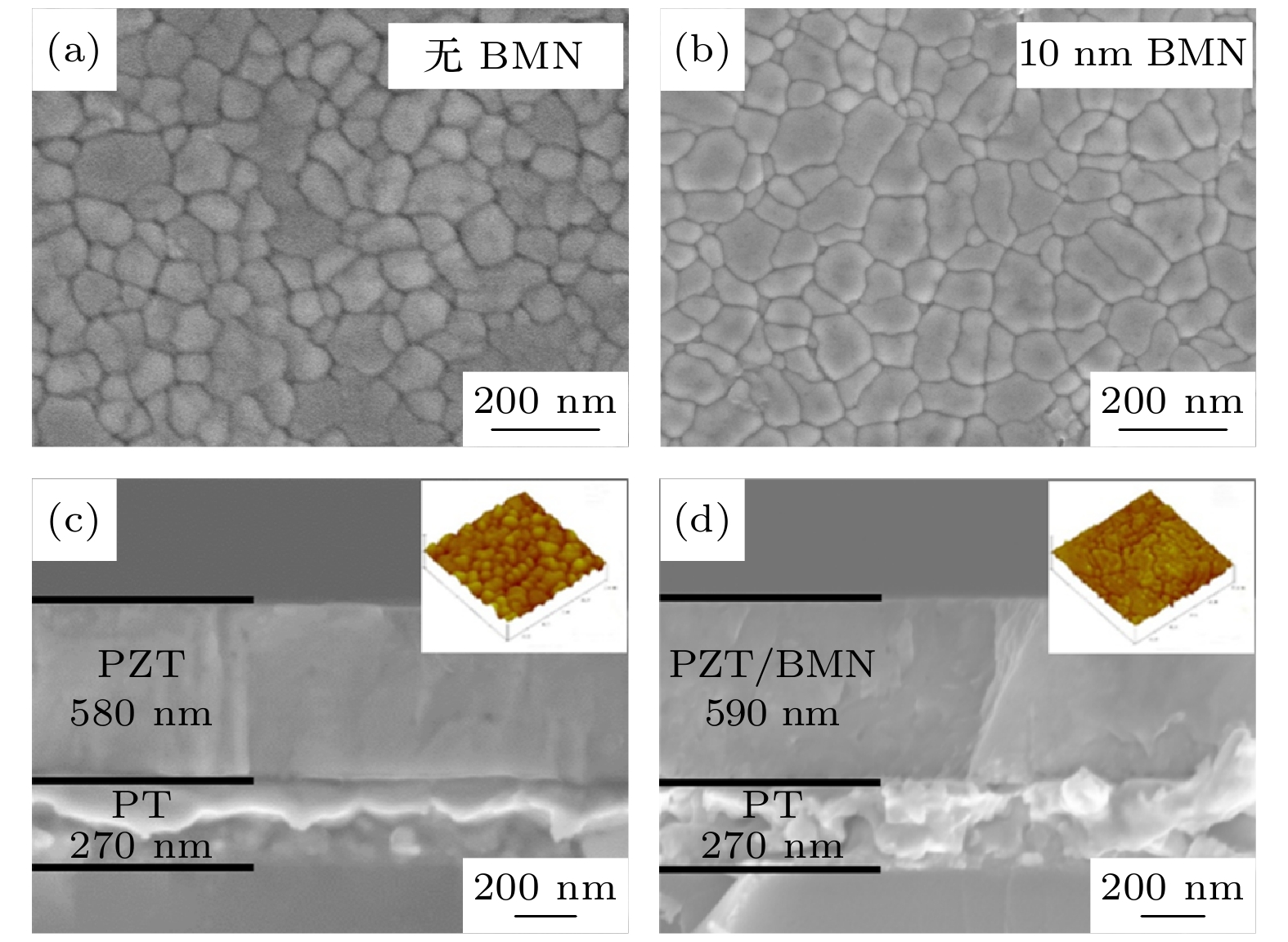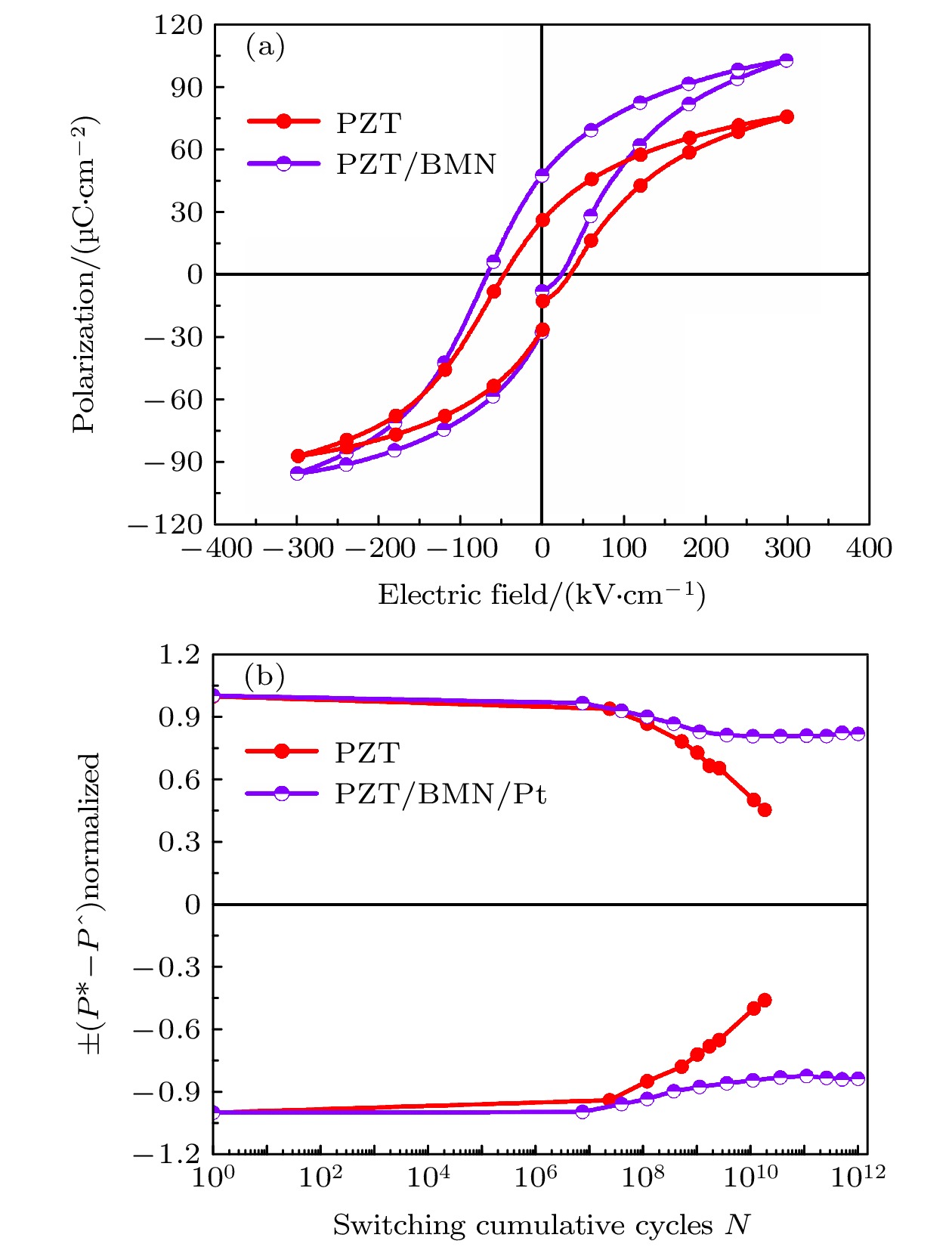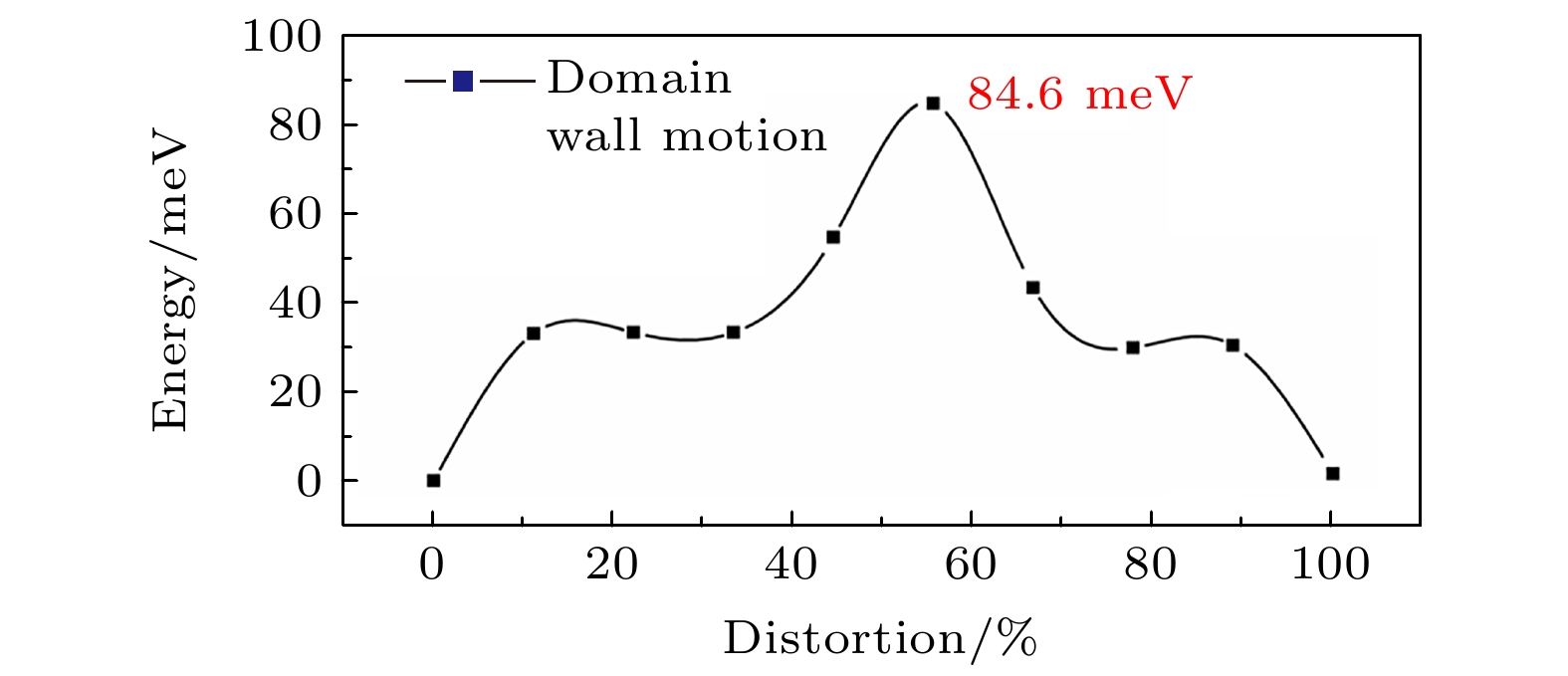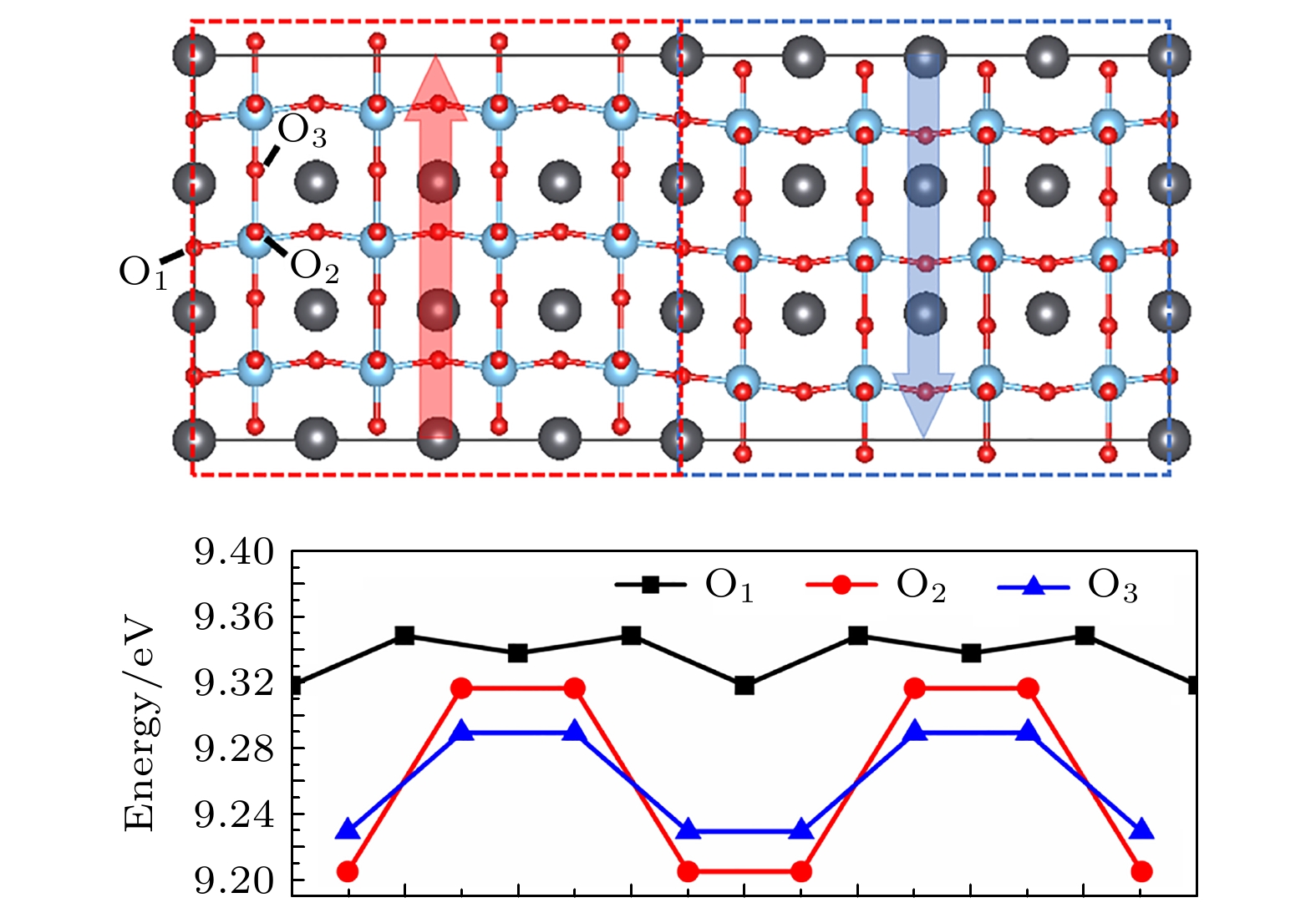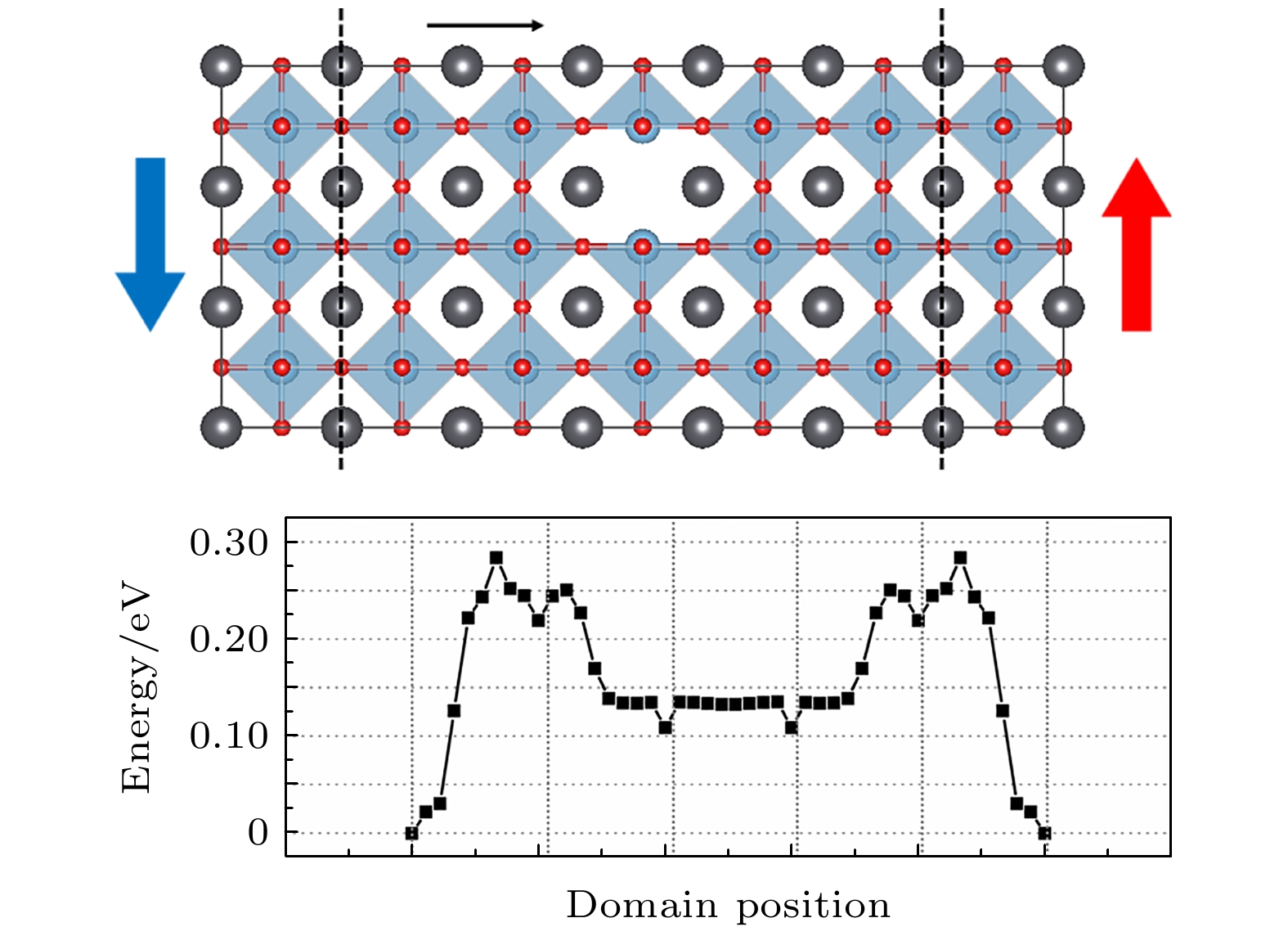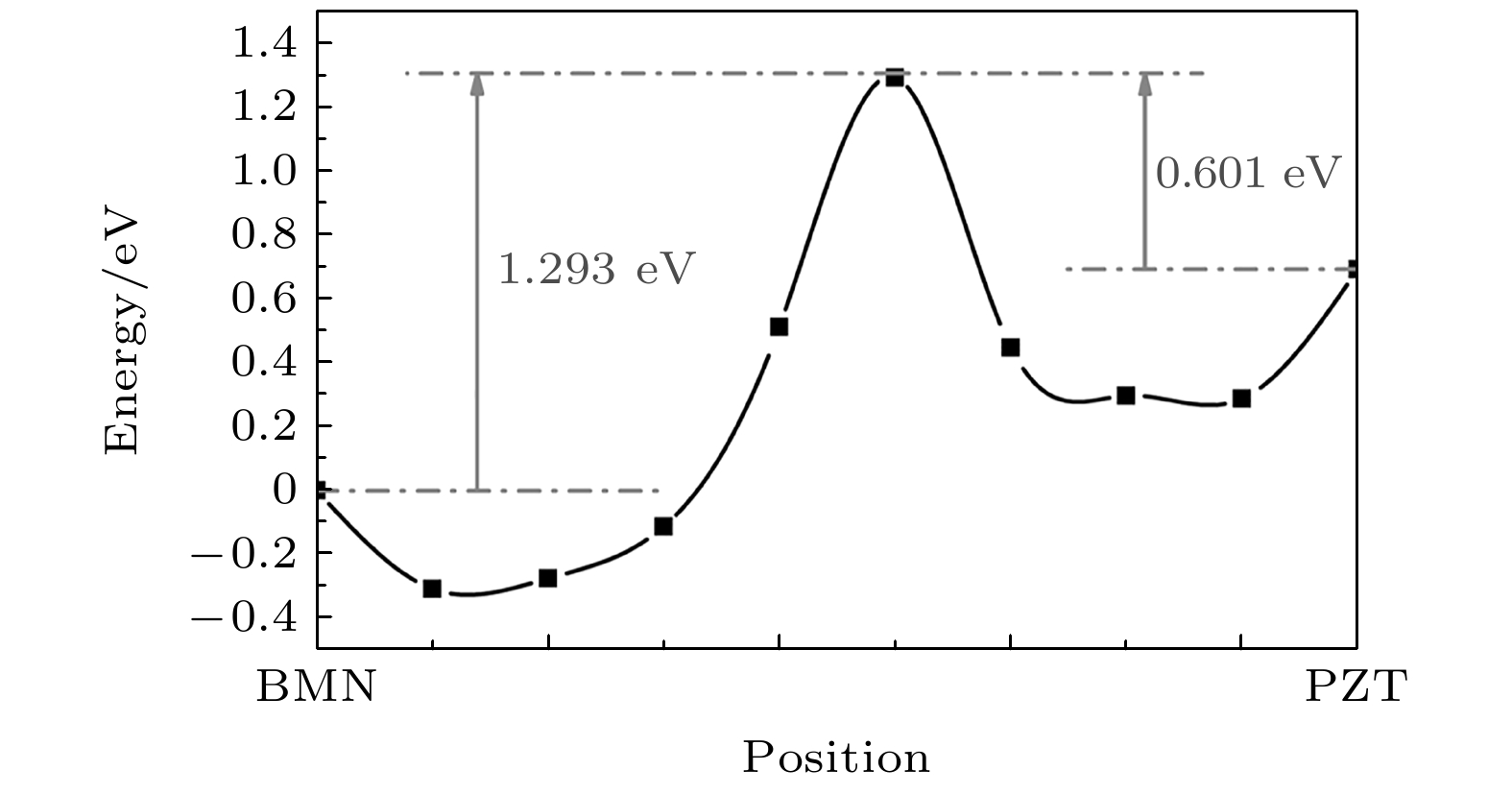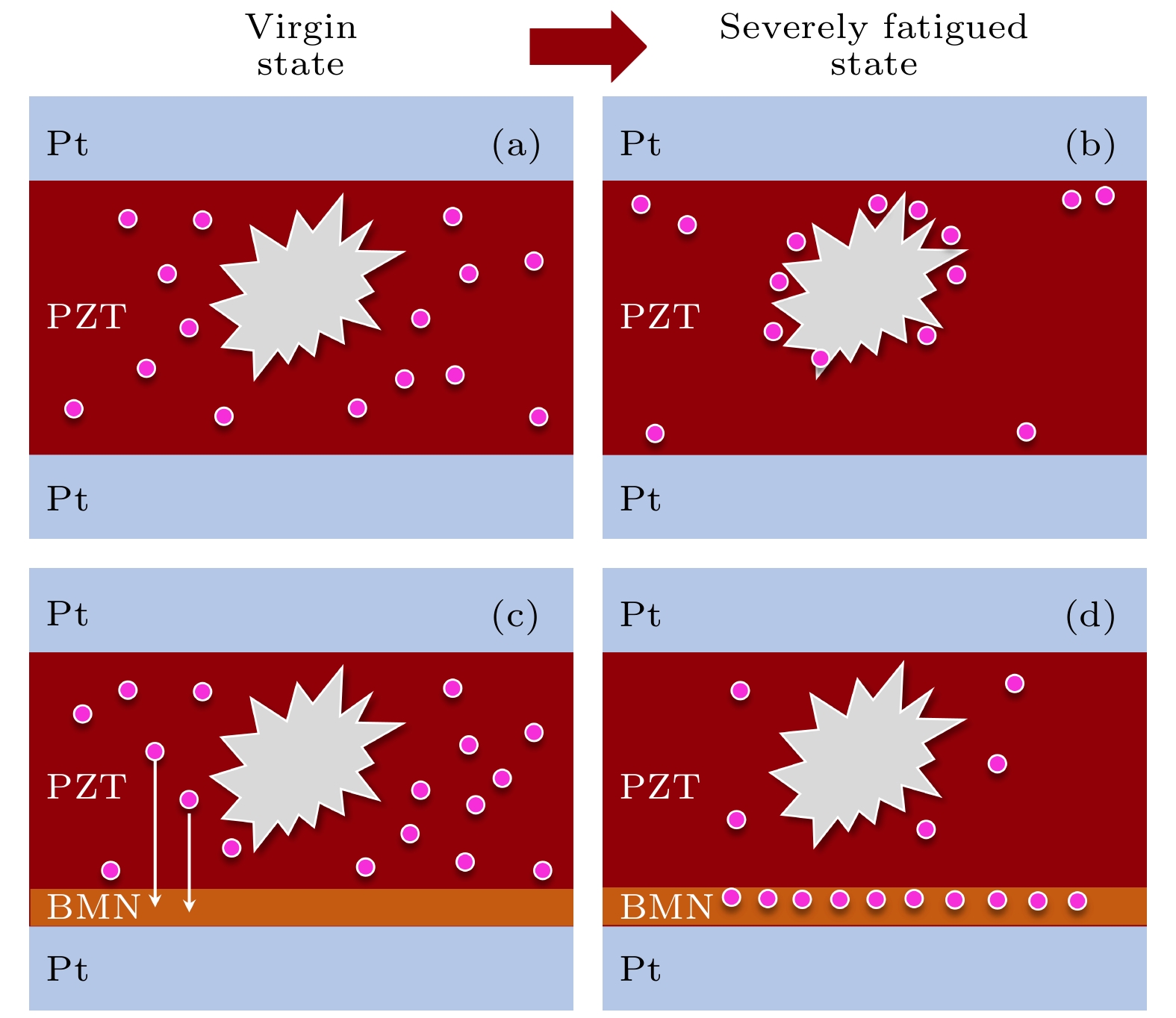-
铁电随机存储器(ferroelectric random access memory, FeRAM)因其卓越的数据存储性能与非易失性存储特性等优势而备受关注, 但其自身固有的铁电疲劳失效问题制约了FeRAM进一步的发展和商业化应用. FeRAM的疲劳失效与铁电薄膜的畴壁运动密切相关, 但其内在疲劳机理仍有待深入研究. 本文采用基于密度泛函理论(density functional theory, DFT)的第一性原理计算方法, 研究了锆钛酸铅 (Pb(Zr0.52Ti0.48)O3, PZT) 的疲劳失效机理并提出了增强其耐疲劳性能的方法. 计算结果表明: PZT中氧空位与180°畴壁运动的耦合是其铁电疲劳的内在原因, PZT铁电薄膜中越靠近畴壁的地方越容易形成氧空位, 畴壁处大量氧空位对畴壁运动的“钉扎”作用使畴壁迁移困难, 抑制了其极化反转最终导致了铁电疲劳; Ba(Mg1/3Nb2/3)O3 (BMN) 缓冲层的存在可吸收PZT中的氧空位, 降低畴壁处的氧空位浓度, 提升其耐疲劳性能. 实验结果表明, 经过1010次极化反转后, PZT 铁电薄膜的剩余极化值降低了51%, 而PZT/BMN薄膜的剩余极化值仅降低了18%; 经过1012次极化反转后, PZT/BMN 薄膜的剩余极化值仍保持有82%并持续稳定. 以上结果表明, BMN缓冲层引入确实能提高PZT铁电薄膜的耐疲劳性, 有望满足FeRAM商业化应用的需求.
-
关键词:
- Pb(Zr0.52Ti0.48)O3 /
- 180°畴壁 /
- 氧空位 /
- 第一性原理计算
Ferroelectric random access memory (FeRAM) has been regarded as a promising technology for next-generation nonvolatile storage due to its excellent data storage performance and nonvolatile storage characteristics. However, fatigue degradation properties seriously impede the development and large-scale commercial use of FeRAM. In this paper, the interaction mechanism and enhancement of ferroelectric fatigue in lead zirconate titanate (PZT) thin film are investigated by the first-principles calculations (DFT). Theoretical calculations suggest that the coupling between oxygen vacancies and 180° domain walls in PZT is responsible for ferroelectric fatigue. Oxygen vacancies are more likely to be formed closer to domain wall, the “pinning” between oxygen vacancies and domain wall makes the migration of domain wall difficult, resulting in the suppression of polarization reversal and ultimately fatigue in ferroelectric thin film. The insertion of Ba(Mg1/3Nb2/3)O3 (BMN) can absorb the oxygen vacancies in PZT and reduce the concentration of oxygen vacancies, and in doing so, the ferroelectric fatigue problem caused by the “pinning” effect of the oxygen vacancies can be eliminated. Moreover, the PZT thin films are deposited on Pt/Ti/SiO2/Si(100) by the sol-gel method with using BMN buffer layer. The remnant polarization (Pr) of PZT film decreases by 51% and the PZT/BMN film remains 85% after 1010 cycles. Furthermore, it keeps stable even up to 1012 cycles. This paper demonstrates that the PZT/BMN film with excellent ferroelectric and fatigue endurance possesses the promising applications in FeRAM. -
Keywords:
- Pb(Zr0.52Ti0.48)O3 /
- 180° domain wall /
- oxygen vacancy /
- first-principles calculation
[1] Tsymbal E Y, Kohlstedt H 2006 Science 313 181
 Google Scholar
Google Scholar
[2] Boni A G, Chirila C, Pasuk I, Negrea R, Pintilie L, Pintilie L 2017 Phys. Rev. Appl. 8 034035
 Google Scholar
Google Scholar
[3] 陈俊东, 韩伟华, 杨冲, 赵晓松, 郭仰岩, 张晓迪, 杨富华 2020 物理学报 69 137701
 Google Scholar
Google Scholar
Chen J D, Han W H, Yang C, Zhao X S, Guo Y Y, Zhang X D, Yang F H 2020 Acta Phys. Sin. 69 137701
 Google Scholar
Google Scholar
[4] 吕笑梅, 黄凤珍, 朱劲松 2020 物理学报 69 127704
 Google Scholar
Google Scholar
Lü X M, Huang F Z, Zhu J S 2020 Acta Phys. Sin. 69 127704
 Google Scholar
Google Scholar
[5] Wang Z Q, Liu Y L, Shen J, Chen W, Miao J, Li A, L K, Zhou J 2020 Sci. China Mater. 63 2497
 Google Scholar
Google Scholar
[6] Deng C, He C, Chen Z, Chen H, Mao R, Liu Y, Zhu K, Gao H, Ding Y 2019 J. Appl. Phys. 126 085702
 Google Scholar
Google Scholar
[7] Wang Z Q, Chen B B, Shen J, Chen W, Liu Y L, Gong S K, Zhou J 2020 Chem. J. Chinese Universities 41 1908
 Google Scholar
Google Scholar
[8] Zhong H, Wen Y, Zhao Y, Zhang Q, Huang Q, Chen Y, Cai J, Zhang X, Li R, Bai L, Kang S, Yan S, Tian Y 2019 Adv. Funct. Mater. 29 1805380
 Google Scholar
Google Scholar
[9] Jiang J, Bai Z L, Chen Z H, He L, Zhang D W, Zhang Q H, Shi J A, Park M H, Scott J F, Hwang C S, Jiang A Q 2018 Nature Mater. 17 2
 Google Scholar
Google Scholar
[10] Ma J, Ma J, Zhang Q, Peng R, Wang J, Liu C, Wang M, Li N, Chen M, Cheng X, Gao P, Gu L, Chen L, Yu P, Nan C 2018 Nature Nanotech. 13 947
 Google Scholar
Google Scholar
[11] Noguchi Y, Matsuo H, Kitanaka Y, Miyayama M 2019 Sci. Rep. 9 4225
 Google Scholar
Google Scholar
[12] Warren W L, Dimos D, Tuttle B A, Nasby R D, Pike G E 1994 Appl. Phys. Lett. 65 87185
 Google Scholar
Google Scholar
[13] Colla E L, Tagantsev A K, Taylor D V, Kholkin A L 2006 Integr. Ferroelectr. 341 3
 Google Scholar
Google Scholar
[14] Grossmann M, Lohse O, Bolten D, Waser R, Hartner W, Kastner M, Schindler G 2000 Appl. Phys. Lett. 76 363
 Google Scholar
Google Scholar
[15] Tagantsev A K, Stolichnov I, Colla E L, Setter N 2001 J. Appl. Phys. 90 1387
 Google Scholar
Google Scholar
[16] Scott J F, Dawber M 2000 Appl. Phys. Lett. 76 25
 Google Scholar
Google Scholar
[17] Jiang A Q, Lin Y Y, Tang T A 2007 J. Appl. Phys. 102 034102
 Google Scholar
Google Scholar
[18] Dawber M, Scott J F 2000 Appl. Phys. Lett. 76 1060
 Google Scholar
Google Scholar
[19] Stolichnov I, Tagantsev A, Colla E, Gentil S, Hiboux S, Baborowski J, Muralt P, Setter N 2000 J. Appl. Phys., 88 2154
 Google Scholar
Google Scholar
[20] Tagantsev A K, Stolichnov I A 1999 Appl. Phys. Lett. 74 1326
 Google Scholar
Google Scholar
[21] Du X, Chen I W 1998 J. Appl. Phys. 83 7789
 Google Scholar
Google Scholar
[22] Kresse G, Furthmüller J 1996 Phys. Rev. B 54 11169
 Google Scholar
Google Scholar
[23] Wu Z, Zhou J, Chen W, Shen J, Hu L, Lü C 2015 J. Sol-Gel Sci. Techn. 75 551
 Google Scholar
Google Scholar
[24] Placeres Jiménez R, Pedro Rino J, Marino Gonçalves A, Antonio Eiras J 2013 Appl. Phys. Lett. 103 112901
 Google Scholar
Google Scholar
[25] Hayashi M 1972 J. Phys. Soc. Japan 33 616
 Google Scholar
Google Scholar
[26] Landauer R 1957 J. Appl. Phys. 28 227
 Google Scholar
Google Scholar
[27] Zhi Y, Liu D, Sun J, Yan A, Zhou Y, Dai E, Liu L, Qu W 2009 J. Appl. Phys. 105 024106
 Google Scholar
Google Scholar
[28] Shin Y H, Grinberg I, Chen I W, Rappe A M 2007 Nature 449 881
 Google Scholar
Google Scholar
[29] Gopalan V, Mitchell T E 1998 J. Appl. Phys. 83 941
 Google Scholar
Google Scholar
[30] Kresse G, Joubert D 1999 Phys. Rev. B 59 1758
 Google Scholar
Google Scholar
[31] Perdew J P, Ruzsinszky A, Csonka G I, Vydrov O A, Scuseria G E, Zhou X, Burke K 2008 Phys. Rev. Lett. 100 136406
 Google Scholar
Google Scholar
[32] Dudarev S L, Botton G A, Savrasov S Y, Humphreys C J, Sutton A P 1998 Phys. Rev. B 57 1505
 Google Scholar
Google Scholar
[33] Lim T L, Nazarov M, Yoon T L, Low L C, Fauzi M N 2014 Phys. Scripta 89 095102
 Google Scholar
Google Scholar
[34] Okamoto S, Millis A J, Spaldin N A 2006 Phys. Rev. Lett. 97 056802
 Google Scholar
Google Scholar
[35] Mizokawa T, Fujimori A 1995 Phys. Rev. B 51 18
 Google Scholar
Google Scholar
[36] Meyer B, Vanderbilt D 2002 Phys. Rev. B 65 104111
 Google Scholar
Google Scholar
[37] Yang Q, Cao J X, Zhou Y C, Zhang Y, Ma Y, Lou X J 2013 Appl. Phys. Lett. 103 141101
 Google Scholar
Google Scholar
[38] Cohen R E 1992 Nature 358 136
 Google Scholar
Google Scholar
[39] Cohen R E, Krakauer H 1992 Ferroelectrics 136 1
 Google Scholar
Google Scholar
-
图 11 体系耐疲劳性增强的机理图 (a), (c)引入BMN 缓冲层前后的体系初始状态; (b), (d) 引入BMN缓冲层前后的体系发生严重疲劳后的状态 (图中圆点表示氧空位)
Fig. 11. The mechanism diagram of system fatigue resistance enhancement: (a), (c) The initial state of the system before and after the introduction of the BMN buffer layer; (b), (d) the state of the system before and after the introduction of the BMN buffer layer after severe fatigue (The dots in the figure indicate oxygen vacancies).
表 1 具有不同PZT单胞数目的体系的畴壁能
Table 1. Domain wall energy of systems with different numbers of PZT unit cells.
n 2 4 6 8 10 ${E_{ {\rm{DW} } } }/({\rm{mJ} } \cdot { {\rm{m} }^{ - 2} })$ 108.5 114.9 116.0 111.4 109.6 注: 其中 n 表示超晶胞中单胞的数量. -
[1] Tsymbal E Y, Kohlstedt H 2006 Science 313 181
 Google Scholar
Google Scholar
[2] Boni A G, Chirila C, Pasuk I, Negrea R, Pintilie L, Pintilie L 2017 Phys. Rev. Appl. 8 034035
 Google Scholar
Google Scholar
[3] 陈俊东, 韩伟华, 杨冲, 赵晓松, 郭仰岩, 张晓迪, 杨富华 2020 物理学报 69 137701
 Google Scholar
Google Scholar
Chen J D, Han W H, Yang C, Zhao X S, Guo Y Y, Zhang X D, Yang F H 2020 Acta Phys. Sin. 69 137701
 Google Scholar
Google Scholar
[4] 吕笑梅, 黄凤珍, 朱劲松 2020 物理学报 69 127704
 Google Scholar
Google Scholar
Lü X M, Huang F Z, Zhu J S 2020 Acta Phys. Sin. 69 127704
 Google Scholar
Google Scholar
[5] Wang Z Q, Liu Y L, Shen J, Chen W, Miao J, Li A, L K, Zhou J 2020 Sci. China Mater. 63 2497
 Google Scholar
Google Scholar
[6] Deng C, He C, Chen Z, Chen H, Mao R, Liu Y, Zhu K, Gao H, Ding Y 2019 J. Appl. Phys. 126 085702
 Google Scholar
Google Scholar
[7] Wang Z Q, Chen B B, Shen J, Chen W, Liu Y L, Gong S K, Zhou J 2020 Chem. J. Chinese Universities 41 1908
 Google Scholar
Google Scholar
[8] Zhong H, Wen Y, Zhao Y, Zhang Q, Huang Q, Chen Y, Cai J, Zhang X, Li R, Bai L, Kang S, Yan S, Tian Y 2019 Adv. Funct. Mater. 29 1805380
 Google Scholar
Google Scholar
[9] Jiang J, Bai Z L, Chen Z H, He L, Zhang D W, Zhang Q H, Shi J A, Park M H, Scott J F, Hwang C S, Jiang A Q 2018 Nature Mater. 17 2
 Google Scholar
Google Scholar
[10] Ma J, Ma J, Zhang Q, Peng R, Wang J, Liu C, Wang M, Li N, Chen M, Cheng X, Gao P, Gu L, Chen L, Yu P, Nan C 2018 Nature Nanotech. 13 947
 Google Scholar
Google Scholar
[11] Noguchi Y, Matsuo H, Kitanaka Y, Miyayama M 2019 Sci. Rep. 9 4225
 Google Scholar
Google Scholar
[12] Warren W L, Dimos D, Tuttle B A, Nasby R D, Pike G E 1994 Appl. Phys. Lett. 65 87185
 Google Scholar
Google Scholar
[13] Colla E L, Tagantsev A K, Taylor D V, Kholkin A L 2006 Integr. Ferroelectr. 341 3
 Google Scholar
Google Scholar
[14] Grossmann M, Lohse O, Bolten D, Waser R, Hartner W, Kastner M, Schindler G 2000 Appl. Phys. Lett. 76 363
 Google Scholar
Google Scholar
[15] Tagantsev A K, Stolichnov I, Colla E L, Setter N 2001 J. Appl. Phys. 90 1387
 Google Scholar
Google Scholar
[16] Scott J F, Dawber M 2000 Appl. Phys. Lett. 76 25
 Google Scholar
Google Scholar
[17] Jiang A Q, Lin Y Y, Tang T A 2007 J. Appl. Phys. 102 034102
 Google Scholar
Google Scholar
[18] Dawber M, Scott J F 2000 Appl. Phys. Lett. 76 1060
 Google Scholar
Google Scholar
[19] Stolichnov I, Tagantsev A, Colla E, Gentil S, Hiboux S, Baborowski J, Muralt P, Setter N 2000 J. Appl. Phys., 88 2154
 Google Scholar
Google Scholar
[20] Tagantsev A K, Stolichnov I A 1999 Appl. Phys. Lett. 74 1326
 Google Scholar
Google Scholar
[21] Du X, Chen I W 1998 J. Appl. Phys. 83 7789
 Google Scholar
Google Scholar
[22] Kresse G, Furthmüller J 1996 Phys. Rev. B 54 11169
 Google Scholar
Google Scholar
[23] Wu Z, Zhou J, Chen W, Shen J, Hu L, Lü C 2015 J. Sol-Gel Sci. Techn. 75 551
 Google Scholar
Google Scholar
[24] Placeres Jiménez R, Pedro Rino J, Marino Gonçalves A, Antonio Eiras J 2013 Appl. Phys. Lett. 103 112901
 Google Scholar
Google Scholar
[25] Hayashi M 1972 J. Phys. Soc. Japan 33 616
 Google Scholar
Google Scholar
[26] Landauer R 1957 J. Appl. Phys. 28 227
 Google Scholar
Google Scholar
[27] Zhi Y, Liu D, Sun J, Yan A, Zhou Y, Dai E, Liu L, Qu W 2009 J. Appl. Phys. 105 024106
 Google Scholar
Google Scholar
[28] Shin Y H, Grinberg I, Chen I W, Rappe A M 2007 Nature 449 881
 Google Scholar
Google Scholar
[29] Gopalan V, Mitchell T E 1998 J. Appl. Phys. 83 941
 Google Scholar
Google Scholar
[30] Kresse G, Joubert D 1999 Phys. Rev. B 59 1758
 Google Scholar
Google Scholar
[31] Perdew J P, Ruzsinszky A, Csonka G I, Vydrov O A, Scuseria G E, Zhou X, Burke K 2008 Phys. Rev. Lett. 100 136406
 Google Scholar
Google Scholar
[32] Dudarev S L, Botton G A, Savrasov S Y, Humphreys C J, Sutton A P 1998 Phys. Rev. B 57 1505
 Google Scholar
Google Scholar
[33] Lim T L, Nazarov M, Yoon T L, Low L C, Fauzi M N 2014 Phys. Scripta 89 095102
 Google Scholar
Google Scholar
[34] Okamoto S, Millis A J, Spaldin N A 2006 Phys. Rev. Lett. 97 056802
 Google Scholar
Google Scholar
[35] Mizokawa T, Fujimori A 1995 Phys. Rev. B 51 18
 Google Scholar
Google Scholar
[36] Meyer B, Vanderbilt D 2002 Phys. Rev. B 65 104111
 Google Scholar
Google Scholar
[37] Yang Q, Cao J X, Zhou Y C, Zhang Y, Ma Y, Lou X J 2013 Appl. Phys. Lett. 103 141101
 Google Scholar
Google Scholar
[38] Cohen R E 1992 Nature 358 136
 Google Scholar
Google Scholar
[39] Cohen R E, Krakauer H 1992 Ferroelectrics 136 1
 Google Scholar
Google Scholar
计量
- 文章访问数: 10223
- PDF下载量: 237
- 被引次数: 0














 下载:
下载:
